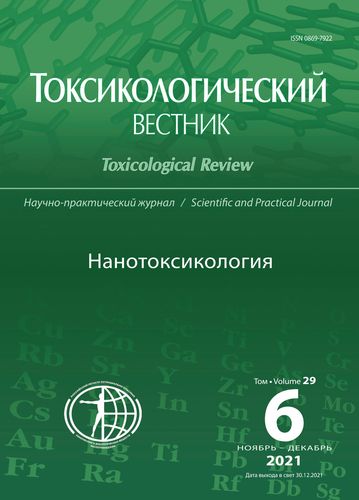Comparison of toxic effects of iron-molybdenum polyoxometalates and mixture of their components
- Authors: Gette I.F.1, Ostroushko A.A.2, Danilova I.G.1, Tonkushina M.O.2
-
Affiliations:
- Institute of Immunology and Physiology UB RAS
- Ural Federal University named after the first president of Russia B.N. Yeltsin
- Issue: No 6 (2021)
- Pages: 54-59
- Section: Original articles
- Published: 23.12.2021
- URL: https://clinpractice.ru/0869-7922/article/view/641419
- DOI: https://doi.org/10.36946/0869-7922-2021-29-6-54-59
- ID: 641419
Cite item
Full Text
Abstract
Introduction. The physicochemical properties and the impact on living organisms of nanoparticles and components that make up nanoparticles may differ radically, however, insufficient attention is paid to a comparative study of the toxicity of nanoparticles and constituents of nanoparticles.
Material and methods. Biochemical and hematological parameters in the blood of 50 male Wistar rats were determined after a single, seven-fold and thirty-fold intramuscular injection of an aqueous solution of iron-molybdenum nanocluster polyoxometalates (POM) and a mixture of the POM components at a dose of 1.5 mg/kg. A solution of a POM components’ mixture was obtained by the destruction of POM with an increase in pH, followed by neutralization, since POM are unstable in an alkaline medium.
Results. The introduction of POM did not cause deviations from the norm in the activity of AST, ALT, total alkaline phosphatase and its bone isoenzyme, α-amylase, protein content, urea and creatinine, which indicates the absence of cytolytic syndrome, including in the liver and myocardium, no damage to the acinar part of pancreas, changes in bone tissue, preservation of the protein-synthetic function of the liver and the filtering ability of the kidneys. The introduction of a solution of POM components (molybdenum, iron) was accompanied by an increase in the activity of AST, alkaline phosphatase, the AST / ALT ratio after 7 injections and an increase in the last two parameters after 30 injections. The impact of POM is characterized by an increase in the content of hemoglobin and erythrocytes in the blood and less pronounced leukopenia, in contrast to the mixture of POM components.
Conclusion. A less pronounced deviation from the norm of biochemical parameters and a lower degree of leukopenia make it possible to assess the effect of POM nanoparticles as less toxic than the action of POM components not organized into nanoparticles.
About the authors
Irina Fedorovna Gette
Institute of Immunology and Physiology UB RAS
Author for correspondence.
Email: i.goette@yandex.ru
ORCID iD: 0000-0003-3012-850X
PhD, Candidate of Biol. Sci., Senior Researcher, Laboratory of Morphology and Biochemistry, Institute of Immunology and Physiology, Ural Branch of the Russian Academy of Sciences, Yekaterinburg, Russian Federation.
e-mail: i.goette@yandex.ru
Russian FederationAleksandr Aleksandrovich Ostroushko
Ural Federal University named after the first president of Russia B.N. Yeltsin
Email: alexander.ostroushko@urfu.ru
ORCID iD: 0000-0003-0206-5513
Доктор химических наук, профессор, зав. Отделом химического материаловедения НИИ физики и прикладной математики, ФГАОУ ВО Уральский федеральный университет им. первого президента России Б.Н. Ельцина, 620002, г. Екатеринбург
e-mail: alexander.ostroushko@urfu.ru
Russian FederationIrina Georgievna Danilova
Institute of Immunology and Physiology UB RAS
Email: ig-danilova@yandex.ru
ORCID iD: 0000-0001-6841-1197
Доктор биологических наук, доцент, зав. лабораторией Морфологии и биохимии, ФБГУН Институт иммунологии и физиологии УрО РАН, 620041, г. Екатеринбург
e-mail: ig-danilova@yandex.ru
Russian FederationMargarita Olegovna Tonkushina
Ural Federal University named after the first president of Russia B.N. Yeltsin
Email: rita-zar@yandex.ru
ORCID iD: 0000-0003-4371-3900
Кандидат химических наук, научный сотрудник Отдела химического материаловедения, ФГАОУ ВО Уральский федеральный университет им. первого президента России Б.Н. Ельцина, 620002, г. Екатеринбург
e-mail: rita-zar@yandex.ru
Russian FederationReferences
- Shurygina I.A., Shurygin M.G. Perspectives of metal nanoparticles application for the purposes of regenerative medicine. Sibirskoe meditsinskoe obozrenie. 2018; 4: 31-7. (in Russian)
- Kadammattil A.V., Sajankila S.P., Prabhu S., Rao B.N., Rao B.S.S. Systemic toxicity and teratogenicity of copper oxide nanoparticles and copper sulfate. J. Nanosci. Nanotechnol. 2018; 18(4): 2394-404.
- Åkerlund E., Cappellini F., Di Bucchianico S., Islam S., Skoglund S., Derr R. et al., Genotoxic and mutagenic properties of Ni and NiO nanoparticles investigated by comet assay, γ-H2AX staining, Hprt mutation assay and ToxTracker reporter cell lines. Environ. Mol. Mutagen. 2018; 59(3): 211-22.
- Gette, I.F., Danilova, I.G., Tonkushina, M.O., Ostroushko, A.A. The impact of iron–molybdenum polyoxometalates and a mixture of nanoparticle components on the content of nucleic acids and histone proteins in rat blood lymphocytes. Nanotechnologies in Russia. 2020; 15(2): 191-7.
- Ostroushko A.A., Grzhegorzhevskii K.V., Medvedeva S.Y., Gette I.F., Tonkushina M.O., Gagarin I.D. et al. Physicochemical and biochemical properties of the Keplerate-type nanocluster polyoxomolybdates as promising components for biomedical use. Nanosystems: physics, chemistry, mathematics. 2021; 12 (1): 81–112.
- Zeinalov O.A., Kombarova S.P., Bagrov D.V., Petrosian M.A., Tolibova G.Kh., Feofanov A.V. et al. About the influence of silver nanoparticles on living organisms’ physiology. Obzory po klinicheskoi farmakologii i lekarstvennoi terapii. 2018; 14(4): 42-51. (In Russian)
- Ostroushko A.A., Tonkushina M.O., Korotaev V.Iu., Prokofeva A.V. Kutiashev I.B. Vazhenin V.A. et al. Stability of polyoxometalate Mo72Fe30 with a buckyball-type structure in solutions. Zhurnal neorganicheskoi khimii. 2012; 57(9): 1292-5. (in Russian)
- Ostroushko A.A., Gette I.F., Brilliant S.A., Danilova I.G. Application of nanocluster iron-molybdene polyoxometalates for correction of experimental posthemorrhagic anemia. Nanotechnologies in Russia. 2019; 14(3–4): 159-64.
Supplementary files









